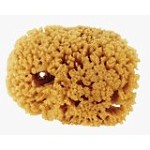It’s not that difficult to create a faux-cloud effect on a ceiling. The size of the ceiling is what determines the effort involved. If your ceiling is large, consider painting only a few billowy clouds in the corners.
To begin, make sure that the surface is smooth, and has a fresh coat of paint in a light sky blue. After the blue base coat has dried thoroughly, mix a glaze in an extremely light blue color, such as Porter Paints #6463-1 or Sherwin Williams Bliss Blue. Most paint manufacturers sell a glaze liquid and will tint the liquid in the color of your choice. Sherwin Williams is called Faux Finishing Glazing Liquid.
 Apply the glaze with a natural sea sponge, applying more glaze in the center of the cloud, thinning and blending as you move to the outside edges. It helps to have photographs of clouds to look at for inspiration as you’re creating. You may want to finish up with a pure white glaze applied lightly and randomly to give a billowy effect to the clouds.
Apply the glaze with a natural sea sponge, applying more glaze in the center of the cloud, thinning and blending as you move to the outside edges. It helps to have photographs of clouds to look at for inspiration as you’re creating. You may want to finish up with a pure white glaze applied lightly and randomly to give a billowy effect to the clouds.
Giving your walls a custom, painted technique is fun and can be tackled by just about anyone. The most important thing on any of the following techniques is to make sure the wall has several coats of base paint. If your base coat is not sufficient, then your glaze or top coat will absorb into the base coat before you have a chance to work it around.
One way to tell if your base coat is nonabsorbent enough is to use a satin or semi-gloss (never a flat paint) and before you begin your glazing, put a small amount of glaze on the base coat, wait a minute, and wipe off. If the paint absorbs into the base coat quicker than desired, add another coat of base paint.
Paint Colors to Use for Final Effect
This may be the hardest part of Faux Painting simply because you are layering colors and the glazes are typically more transparent than if they were in their original paint form. A deep green paint made into a glaze may come out several shades lighter than you expected. If yours turns out too light, you can always add darker tints to deepen it, this will save you from starting all over.


2 Responses
In your article you mention it best to use a natural sea sponge. I found that there are several different types our there including Wool, Yellow and Grass sponges, which do you recommend?
Sponge used for faux painting is the type of sea sponge you will need. These can be found at your local paint store or big box hardware store.